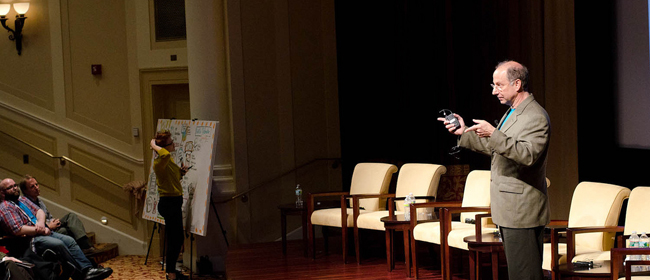Government Publications – Enhanced Access & Discovery through Open Linked Data & Crowdsourcing
Government Publications: Enhanced Access and Discovery through Open Linked Data and Crowdsourcing is a collaborative project from the University of Minnesota, HathiTrust, and the Committee on Institutional Cooperation (CIC). John Butler and Wendy Lougee presented.
The US government is one of the largest publishers of information in the world and represents a key source of information regarding US history and culture, much of which exists in the public domain. The CIC has about 500,000 digitized documents so far, and this Beta Sprint project focuses on enhancing this growing collection of digitized government documents through the development and implementation of useful services for end users. The first service concept presented makes use of linked data, RDF triples, and databases such as the Library of Congress Name Authority File, the Virtual International Authority Files, and WorldCat Identities in order to deal with often-changing US government agency names and committees. For example, when a user does a search for documents related to the “US Coast Guard”, they would get back not only those documents directly related to the “US Coast Guard”, but also documents related to any other name the Coast Guard may have gone by over the years. The second service concept utilizes linked data, RDF triples, and user tagging to build relationships between legislative documents in order to create navigable legislative histories and link relevant legislation together in a meaningful way.
Metadata Interoperability Services
Metadata Interoperability Services (MINT), presented by Stefanos Kollias and Nasos Drosopoulos of the National Technical University of Athens, is a web-based platform that implements and supports the aggregation of rich and diverse cultural heritage content and metadata. The process is broken down into three main steps. The first is to gather and upload a given provider’s metadata in XML. The second is to implement and formalize crosswalks between provider (starting point) and aggregation (target point) data models via a visual mapping editor and XSLT. In addition to simple one-to-one mappings, MINT offers tools for conditional and structural mapping to allow crosswalking between more complex metadata schema. And finally, the third step in the process is to remediate and then host these aggregated metadata records.
ShelfLife and Library Cloud
David Weinberger of the Harvard Library Innovation Lab presented ShelfLife and Library Cloud. Library Cloud is a metadata server that gathers metadata from various institutions and collections and makes it available through various APIs as open, linked data. It is also the backend metadata server that supports ShelfLife, an application that creates visualizations of digital books as they might exist on a shelf, and allows users to browse and scroll through them. These representations of books can then be arranged in many different facets, enhancing contextual understanding and facilitating serendipitous discovery. ShelfLife also has an extremely robust recommendation system based on aggregated anonymous usage data, user-created collections, user ratings, and user tags. In addition to providing a familiar digital equivalent to browsing library shelves, ShelfLife and LibraryCloud aim to make what the DPLA knows about library items part of what the Internet and the open linked data world know about library items.
The first installment of the Beta Sprint presentations is available here.
The third installment of the Beta Sprint presentations is available here.
